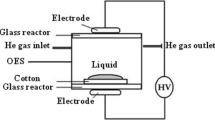Abstract
In this paper, long-lived free radicals in atmospheric-pressure DBD plasma were used to treat PET yarn surface. Subsequently, the drag force of treated yarns in air flow at four humidities (40 ± 3, 50 ± 3, 60 ± 3, 70 ± 3%) was measured. The results suggest that with the increase of flow humidity, the air drag force of untreated yarn decreased while that of plasma-treated ones on average increased gradually. The average growth rates of the drag force under each humidity were 5.33, 7.58, 10.08 and 12.28% respectively. Meanwhile, the air drag force of the yarns treated at different specific input energy (SIE) densities and treatment time varied obviously under different flow humidity. The X-ray photoelectron spectroscopy analysis was performed to characterize the yarn surfaces chemically. The topology and roughness of PET yarns were measured by atomic force microscopy. The tensile test was carried out to characterize the mechanical strength. The ozone, nitrate and nitrite radicals and total organic carbon in tail gas of plasma were also analyzed. The maximal atomic concentration of N element on PET surface could reach 8.0%. The obtained results can improve the understanding of the property of long-lived reactive species from DBD plasma source generated at different SIE and the difference in PET surface etching and modification during remote treatment at different SIE. Moreover, the results also provide an experimental guideline for the improvement of weaving efficiency in air-jet weaving.









Similar content being viewed by others
References
Borcia G, Anderson CA, Brown NMD (2006) Surf Coat Technol 201:3074–3081
Morent R, De Geyter N, Verschuren J, De Clerck K, Kiekens P, Leys C (2008) Surf Coat Technol 202:3427–3449
Kamlangkla K, Hodak SK, Levalois-Grützmacher J (2011) Surf Coat Technol 205:3755–3762
Tsafack MJ, Levalois-Grützmacher J (2006) Surf Coat Technol 200:3503–3510
Tsafack MJ, Levalois-Grützmacher J (2007) Surf Coat Technol 201:5789–5795
Relvas C, Castro G, Rana S, Fangueiro R (2015) Plasma Chem Plasma Process 35:863–878
Yang L, Chen J, Guo Y, Zhang Z (2009) Appl Surf Sci 255:4446–4451
Bartis EAJ, Knoll AJ, Luan P, Seog J, Oehrlein GS (2016) Plasma Chem Plasma Process 36:121–149
Ormerod A, Sondhelm WS (1995) Weaving technology and operation. The Textile Institute, Manchester
Mohamed MH, Salama M (1986) Text Res J 56(11):683–690
Mohamed MH, Salama M (1986) Text Res J 56(12):721–726
Ishida M, Okajima A (1991) J Text Mach Soc Jap 44(4):43–54
Ishida M, Okajima A (1994) Text Res J 64(1):10–20
Jeong SY, Kim KH, Choi JH, Lee CK (2005) Int J Precis Engng Manuf 6(1):23–30
Adamek K (1999) Comput Assisted Mech Eng Sci 6(4):251–261
Kim SD, Song DJ (2001) Text Res J 71(9):783–790
Belforte G, Mattiazzo G, Viktorov V, Visconte C (2009) Text Res J 79(18):1664–1669
Vangheluwe L (1997) Text Res J 67(11):809–815
Liu S, Feng Z, Liu D, Zhang X, Zhang L (2015) Text Res J 86(20):2140–2150
Chen X, Bian W, Song X, Liu D, Zhang J (2013) Sep Purif Technol 120:102–109
Bader H, Hoigné J (1981) Water Res 15:449–456
State Environmental Protection Administration of China, Standard Analytical Methods for Air and Exhausted Gas Monitor (Chinese) (2003) Environmental Science Press, China
Bian W, Song X, Liu D, Zhang J, Chen X (2013) Chem Eng J 219:385–394
Zeng M, Zhao K, Lu Y, Ouyang Y, Liu D, Wang M, Ma Y (2015) Plasma Chem Plasma Process 35:721–738
Cao L, Xie X, Zeng J, Huang H (2013) Appl Mech Mater 345(345):48–53
Bartis EAJ, Luan P, Knoll AJ, Hart C, Seog J, Oehrlein GS (2015) Biointerphases 10:029512–029520
Pavlovich MJ, Clark DS, Graves DB (2014) Plasma Sour Sci Technol 23:065036–065043
Waring MS, Wells JR (2015) Atmos Environ 106:382–391
Kostov KG, Nishime TMC, Hein LRO, Toth A (2013) Surf Coat Tech 234:60–66
O’Hare LA, Leadley S, Parbhoo B (2002) Surf Interface Anal 33:335–342
Sellin N, Campos JSC (2003) Mater Res. 6:163–166
Acknowledgements
The financial support of this work by the projects funded by the Priority Academic Program Development of Jiangsu Higher Education Institutions (PAPD), the National High Tech Research and Development Program of China (‘863’ Program, No. SQ2009AA06XK1482331), ‘Jin Shan Ying Cai’ and ‘Chang Shan Ren Cai’ Programs (Zhenjiang, Jiangsu, China) is gratefully acknowledged.
Author information
Authors and Affiliations
Corresponding authors
Rights and permissions
About this article
Cite this article
Liu, S., Wang, M., Ma, Y. et al. Research on the Effect of Dielectric Barrier Discharge (DBD) Plasma Remote Treatment on Drag Force of Polyethylene Terephthalate (PET) Yarns in Air Flow with Different Humidities. Plasma Chem Plasma Process 37, 1573–1586 (2017). https://doi.org/10.1007/s11090-017-9838-2
Received:
Accepted:
Published:
Issue Date:
DOI: https://doi.org/10.1007/s11090-017-9838-2




